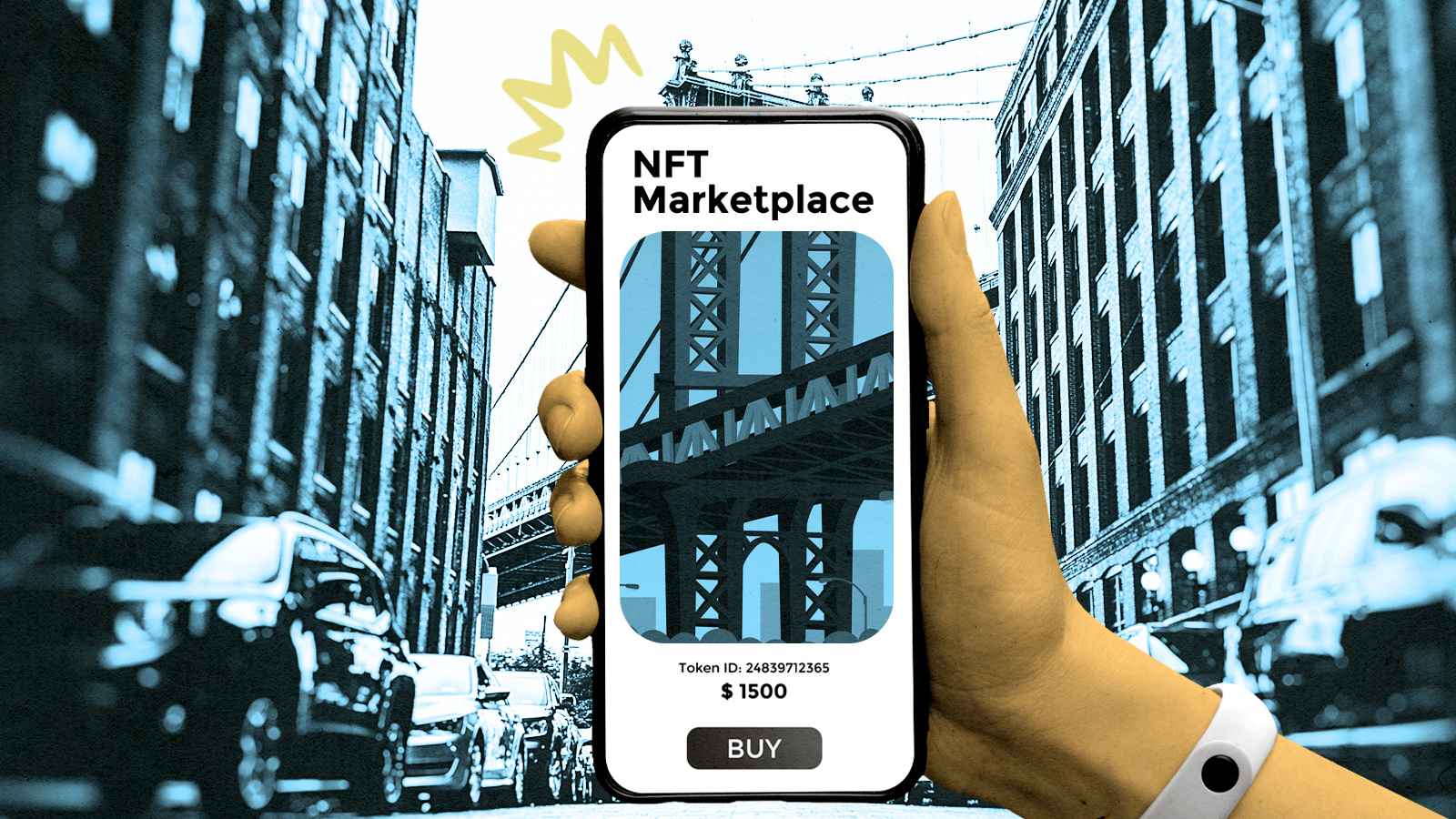If you lived here, you'd be rich already
How NFTs are introducing the internet's next phase


NFT art is officially in the Zeitgeist. Twitter supports NFT avatars, celebrities like Justin Bieber and Jimmy Fallon are buying Bored and MutantApes, and Martha Stewart is selling NFT images of her bucolic farm on a digital store named FreshMINT. Arts organizations like Christie's, LACMA, and San Francisco's Grey Area — as well as education sites like Skillshare and Udemy — are offering intro to NFT courses with primers on minting and buying digital art.
As with any new cultural phenomenon, debate is heating up as to whether NFT art is good looking, good for the art industry or a good investment. Whatever consensus emerges, however, the result right now is people are talking about NFTs all day long. In other words, things are going exactly as planned to make Web3 — the concept of a token-based economy — the next hot neighborhood on the internet.
The story of Dumbo's transformation from industrial wilderness to pricey paradise may be instructive for this moment. In the 1980s, Manhattan and Brooklyn real estate company Two Trees Management bought up the area and gave artists and artist institutions rental deals they couldn't refuse. Two Trees' owners, the Walentas family, understood that an art scene would lend the underdeveloped area under the Manhattan Bridge a cultural credibility that could eventually translate to broader desirability and even lucrative bidding wars.
The Week
Escape your echo chamber. Get the facts behind the news, plus analysis from multiple perspectives.

Sign up for The Week's Free Newsletters
From our morning news briefing to a weekly Good News Newsletter, get the best of The Week delivered directly to your inbox.
From our morning news briefing to a weekly Good News Newsletter, get the best of The Week delivered directly to your inbox.
Many artists at the time knew the breaks wouldn't last forever, but they took advantage of the opportunity. "Clearly, [Walentas] wants to make a buck," artist Chuck Close told The New York Times in 2008. "But it's community building." And the strategy worked beautifully. By 2021, Dumbo's average asking price per square foot was one of the highest in Brooklyn.
The vision put forth by Web3 advocates and investors today is a landscape of virtual real estate, one where property rights are verified by the (theoretically uncorrupted and unbiased) blockchain rather than regulated institutions and problematic Big Tech platforms like Facebook and Amazon. The concept, in which everyone can own their own digital parcel of land and run their own digital storefront, has been circulating in technical audiences for over a decade. But with the viral marketing of social media-friendly NFT art, it's finally getting broader interest.
Not unlike how real estate developers have used artist communities to make an emerging neighborhood more attractive, Web3 advocates are pushing NFT art into popular media to sell an internet that doesn't yet exist — but could, if enough people buy into it. Celebrity investors promote NFT art on talk shows and to reporters just as they would a new movie. In her appearance on The Tonight Show, for example, Paris Hilton (an investor in Foundation, another NFT platform) gave the entire audience NFTs, recruiting hundreds of new collectors with one publicity stunt. And because NFTs can only be claimed through a digital wallet, every single audience member had to buy into the system to access Hilton's gift.
But what did they actually get?
A free daily email with the biggest news stories of the day – and the best features from TheWeek.com
NFTs are units of data that can be traded in an online marketplace. The format doesn't dictate that they're creative or visual, and in fact, the visual nature of NFT art can confuse buyers about the nature of the token (as in, non-fungible token, the basis of the better-known NFT name). A collection of strangers recently learned this lesson when they bought an NFT of the book Dune for $3 million — that is, the data of one instance of the book — then tried to distribute it without owning the copyright.
Today, NFT art may be sold off like Beanie Babies, but when that data is used for a digital contract or proof of ownership for a real-world asset, NFTs have the potential to support regulation-free financial operations of all kinds. That's how they can become the infrastructure of the Web3 environment.
This is where the rubber meets the road for Web3 promoters, because it's where the real money is. But to make those billions, Web3 advocates need the online marketplace to reach a critical mass of participants. If Paris Hilton went on TV to pitch how she can now sign a binding document using digital tokens instead of a lawyer, the audience would fall asleep, not shriek with delight. NFTs are bringing in customers who may one day use this technology to buy something much more valuable and tangible than a picture of an ape.
At the North American Bitcoin Conference in January, billionaire investor and media personality Mark Cuban admitted as much. NFTs are "just a proof of concept for what you can do with smart contracts and decentralization," he said. And Web3 investors are already focused on what's next for NFTs.
One direction is real-life real estate. A startup called Propy sold a property in the Ukraine last year using NFTs, and in February, they're moving their efforts to the U.S., auctioning a Florida apartment using NFTs and working on the frameworks to operationalize the process for any real estate asset. Other companies, like RealT and RealBlock, offer fractional real estate ownership through the blockchain, targeted at international buyers. Still ohers, including SMARTRealty, are using their own tokens to digitize the entire property-buying process. In its 2022 housing report, Sotheby's predicted crypto could even drive a luxury real estate boom.
What does this mean for the artists who are dedicating time and resources to learning the technology required for NFT art, paying hundreds in minting and gas fees per artwork, and advocating for others within their own communities to join? Artists and collectors should be prepared to find the current NFT art craze is a bubble, subsidized by what are essentially the marketing and publicity budgets of crypto investors. The value of NFT art could take a nosedive once the format shifts into its more logistical role and funding moves onto the next hot industry.
And while individuals can certainly leverage the opportunity of the current moment, Dumbo's story may predict the future: Artists should get ready to be pushed to the sidelines for the next phases of development in the Web3 landscape. And the rest of us should get ready for a lot fewer jokes about apes in the news.
Rebecca Ackermann is a writer, designer, and artist living in San Francisco. Her writing has appeared in The New York Times, Newsweek, Wigleaf, and elsewhere. As a designer, she has worked on AI for healthcare, VR for education, and consumer transparency tools with Google, NerdWallet, and others. In a previous life, she staffed at NYC independent magazines Heeb and Index.
-
 Political cartoons for December 14
Political cartoons for December 14Cartoons Sunday's political cartoons include a new White House flag, Venezuela negotiations, and more
-
 Heavenly spectacle in the wilds of Canada
Heavenly spectacle in the wilds of CanadaThe Week Recommends ‘Mind-bending’ outpost for spotting animals – and the northern lights
-
 Facial recognition: a revolution in policing
Facial recognition: a revolution in policingTalking Point All 43 police forces in England and Wales are set to be granted access, with those against calling for increasing safeguards on the technology
